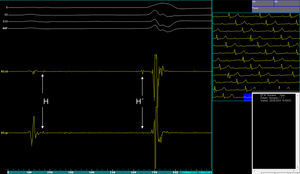To the Editor,
Percutaneous aortic valve implantation is an alternative to surgery in the treatment of severe symptomatic aortic stenosis in patients at high surgical risk.1,2 The series published with the percutaneous implantation of the CoreValve® (Medtronic CV, Luxembourg) aortic valve prosthesis show a high success rate. However, a high incidence of conduction disorders has been described, with frequent occurrence of left bundle branch block and complete atrioventricular (AV) block in 20%-35% of cases.3,4
We report the case of an 83-year old patient diagnosed with severe symptomatic aortic stenosis who was rejected for surgery due to the high surgical risk involved. He was implanted with a CoreValve® percutaneous aortic valve prosthesis. An electrophysiological study was performed on the patient immediately before the procedure, and normal conduction parameters were obtained: AH interval of 52ms, HV 40ms; functional and effective refractory periods of the AV node of 420ms and 290ms, and Wenckebach point of 320ms. An electrocatheter was maintained in the bundle of His with conduction intervals recorded throughout the procedure. During the release of the prosthesis, the patient had complete and permanent intra-Hisian AV block (Figure 1). A permanent pacemaker was therefore implanted. The patient was still pacemaker-dependent at the follow-up after 18 weeks, with a percentage stimulation of 100%.
Figure 1. Complete atrioventricular block (top right panel) appeared after deployment of the percutaneous aortic valve prosthesis. Distal and proximal His electrograms are shown (left panel) which are characteristic of intra-Hisian location blocking (H-H’).
ECG changes suggesting a lesion towards the bundle of His have been described in the literature, such as the widening of the QRS with or without left bundle branch block, though this was not shown electropysiologically.5,6 For the first time, this case shows the effect of implanting a percutaneous aortic valve prosthesis in the conduction tissue, affecting the bundle of His in particular, the part of the conduction system closest to the aortic annulus.
Conflicts of interestDr. César Morís is Proctor for Medtronic, Inc., for the implantation of the CoreValve percutaneous aortic valve prosthesis.
Received 6 October 2010
Accepted 25 October 2010
Corresponding author: jmrl100@gmail.com (J.M. Rubín)


